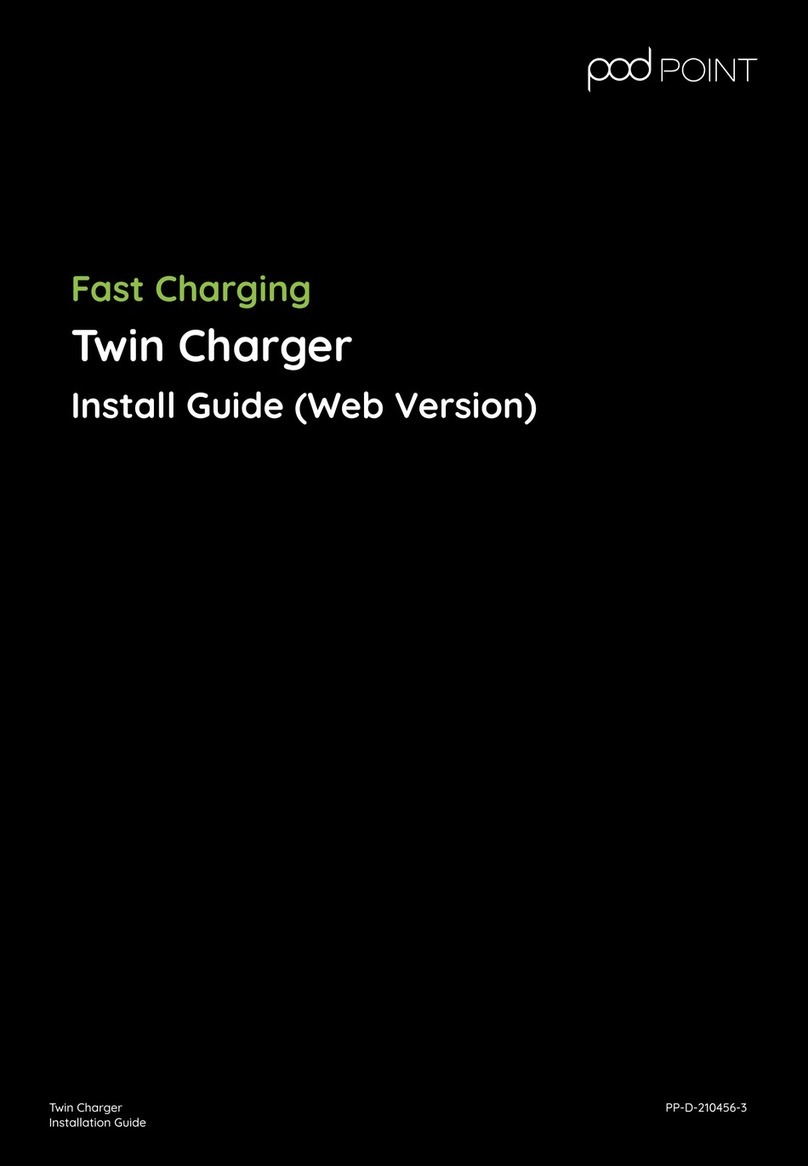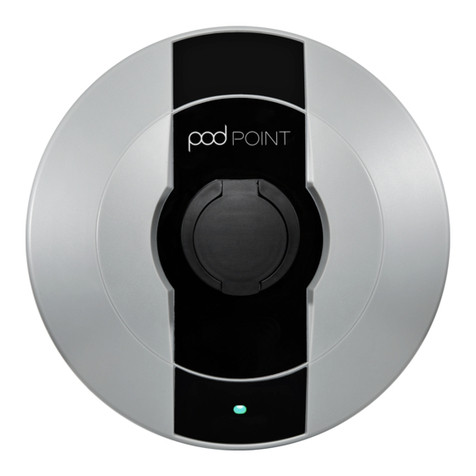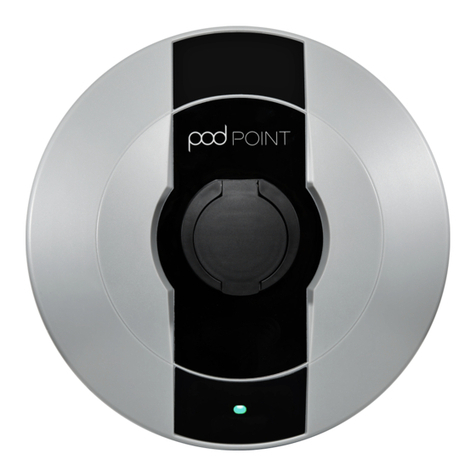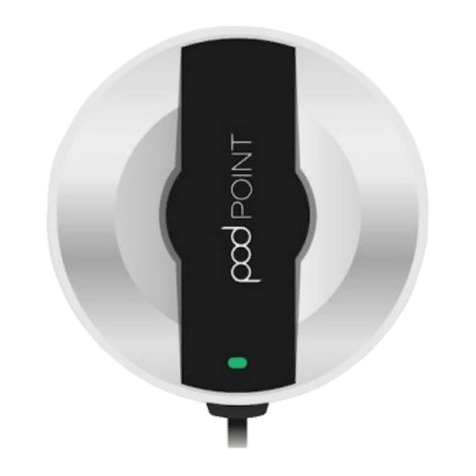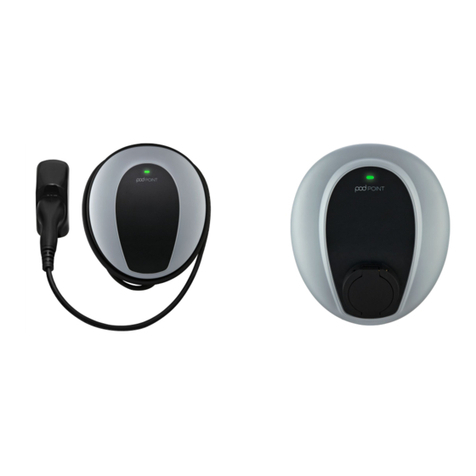
Introduction
This guide is intended for
use by competent electrical
installers to explain the
basic requirements and
options to be considered
when installing a Pod Point
Solo Mode 3 electric vehicle
charging point. The Pod
Point Solo is designed for
installations in or outside, the
advanced safety systems
we have built in to the unit
ensure its safe usage,
this guidance provides information to assist when
installing the new Pod-Point Solo. This guide should not
be used for any other EVSE as they do not include these
safety systems.
Important safety information
Warning! The Pod Point Solo charging unit is
manufactured to be safe and without risk provided
they are professionally installed, used and maintained
in accordance with the manufacturer’s instructions
and recommendations and installed by competent
electrical installers in accordance with national and local
regulations and legislation applicable at the time of
installation, e.g.: BS7671:2018.
The Pod Point is designed to be connected to one
dedicated AC supply only. The property must comply
with minimum BS7671 standards before installation
commences. As of the 1st January 2019 either a Type B
RCD must be used or a Type A with 6mA DC protection
included in the Pod-Point (see detail on packaging to
determine what protection is required),
Important note: A DC leakage
fault in the vehicle may “blind”
a type “AC” RCD and render
it ineective, never feed
any EVSE from an existing
upstream Type “AC” RCD.
Locating the Pod Point Solo
The Pod Point can be tted
inside or outside, the installer
should consult the EV owner
to establish their preferred
installation location. This should
take into consideration the cable
length (distance to vehicle being
charged), risk of vehicle impact
and obstruction of access etc.
It is recommended the
Pod Point be mounted at
a height of 750mm-1.2m (
Fig. 2 ), (Building regulations
BS8300:2018 recommends
450~1200mm, BS7671:2018
recommend 500~1500mm).
Technical details
The Point Solo is designed to meet the following
European standards: IEC61851-1 edition 3 (2017), Low
Voltage Directive (LVD) 2014/35/EU and EMC Directive
2014/30/EU. During manufacture each Pod Point has
been functionality tested for safety using BS EN 61010
& BS EN 61557 approved equipment. The Pod Point Solo
is a Class I/II rated device for 230V / 400V AC 50Hz
systems and is IP54 rated. This installation guide is in
accordance to the latest BS7671: 2018.
Earth arrangements
The new Pod Point Solo features an on-board safety
monitoring system to detect low voltage supplies and
potential earth-neutral faults, If such a condition is
encountered the charge cycle is ended or prevented and
the Pod-Point eectively becomes a double insulated
(class II) device. The vehicle becomes isolated from the
incoming supply and poses no risk to touch.This feature
removes the requirement for an earth electrode where
it may be ineective or introduce further risk. The Pod
Point Solo unit (tethered or socketed) may be connected
directly to a TN-C-S (PME) earthing system without any
special arrangements, the new Pod Point solo complies
with regulation 722.411.4.1 (iii) of BS7671: 2018.
It remains the responsibility of the installer to conduct
a risk assessment of the immediate area to a range
of 10 Meters (equipotential zone) to ensure no other
conductive metal xings pose risks (mixture of TT/TN-S
and TN-C-S), this is important where cable length may
enable charging inside or outside of a building/garage
where the vehicle is within touch distance.
Where certain conditions dictate an earth electrode
must be used it shall be independent from the
distributors earth system with no direct interconnection
(the incoming supply SWA protective earth should be
isolated from the housing and/or earth electrode).
The electrical installer shall install a suitable electrode
complete with termination housing and covers where
appropriate, warning labels should be visible and close
to the unconnected SWA protective earth (e.g inside the
Pod-Point).
The earth connection shall be made from the electrode
to the Pod Point Solo via copper conductor earth wire
of an appropriate CSA for the installation. The earth
wire shall be installed in conduit where there is a risk of
mechanical damage or UV exposure.
* Note 1: Unless SWA is used, if a cable passes through
any metallic material (signage etc..) this will also require
bonding to earth, see separate documentation supplied
with Pod-Point signage if included.
* Additional note: Pod Point recommend Earth electrode
impedance to be < 100 ohms.
Pod Point Solo Unit
Installation Guide
Pod Point Solo -
Universal Version
Pod Point January 2019
PP-D-130012-14
Pod Point Solo Install Guide 1
750mm - 1200mm
365mm
150mm
Depth
Fig. 2
Dimensions and location of
unit (150mm depth)
Fig. 1
RCD Markings
